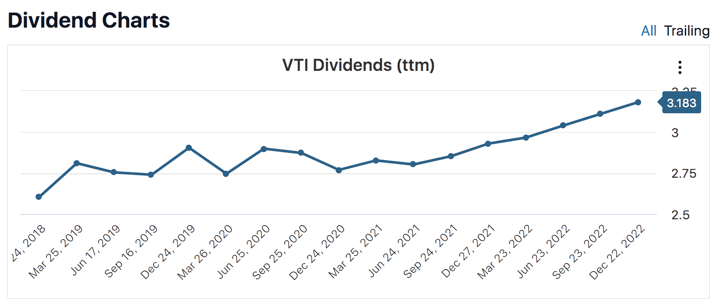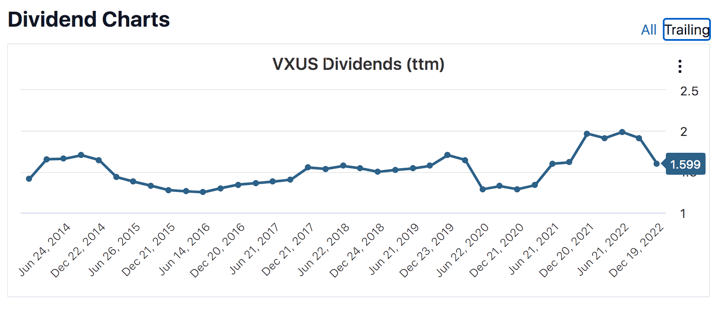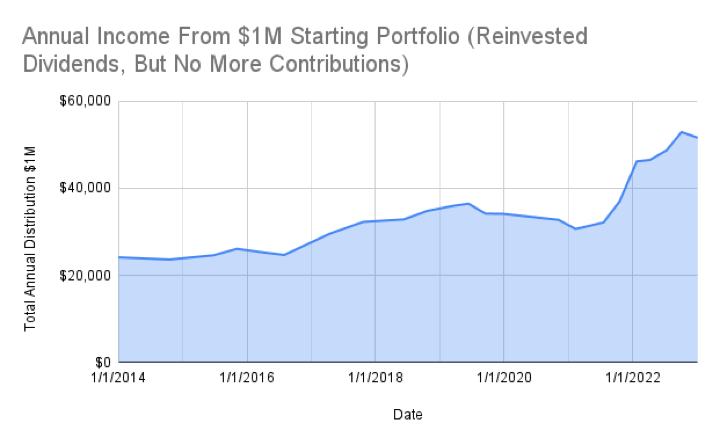 Here’s my 2022 Year-End income update for my Humble Portfolio. I track the income produced as an alternative metric for performance. The total income goes up much more gradually and consistently than the number shown on brokerage statements (price), which helps encourage consistent investing. I imagine my portfolio as a factory that churns out dollar bills.
Here’s my 2022 Year-End income update for my Humble Portfolio. I track the income produced as an alternative metric for performance. The total income goes up much more gradually and consistently than the number shown on brokerage statements (price), which helps encourage consistent investing. I imagine my portfolio as a factory that churns out dollar bills.
Short recap about dividends. Stock dividends are a portion of net profits that businesses have decided to distribute directly to shareholders, as opposed to reinvesting into their business, paying back debt, or buying back shares directly. The dividends may suffer some short-term drops, but over the long run they have grown faster than inflation.
In the US, the dividend culture is somewhat conservative in that shareholders expect dividends to be stable and only go up. Thus the starting yield is lower, but grows more steadily with smaller cuts during hard times. Here is the historical growth of the trailing 12-month (ttm) dividend paid by the Vanguard Total US Stock ETF (VTI), courtesy of StockAnalysis.com. Unfortunately, they recently shortened their lookback period on their charts.

European corporate culture tends to encourage paying out a higher (sometimes fixed) percentage of earnings as dividends, but that also means the dividends move up and down with earnings. Thus the starting yield is higher but may not grow as reliably. Here is the historical growth of the trailing 12-month (ttm) dividend paid by the Vanguard Total International Stock ETF (VXUS).

The dividend yield (dividends divided by price) also serve as a rough valuation metric. When stock prices drop, this percentage metric usually goes up – which makes me feel better in a bear market. When stock prices go up, this percentage metric usually goes down, which keeps me from getting too euphoric during a bull market. Here’s a related quote from Jack Bogle (source):
The true investor will do better if he forgets about the stock market and pays attention to his dividend returns and to the operating results of his companies.
My personal portfolio income history. I started tracking the income from my portfolio in 2014. Here’s what the annual distributions from my portfolio look like over time:
- $1,000,000 invested in my portfolio as of January 2014 would have generated about $24,000 in annual income over the previous 12 months. (2.4% starting yield)
- If I reinvested the income but added no other contributions, over the year of 2022 it would have generated ~$51,500 in annual income over the previous 12 months.
This chart shows how the annual income generated by my portfolio has increased over time and with dividend reinvestment.

TTM income yield. To estimate the income from my portfolio, I use the weighted “TTM” or “12-Month Yield” from Morningstar (checked 1/6/23), which is the sum of the trailing 12 months of interest and dividend payments divided by the last month’s ending share price (NAV) plus any capital gains distributed (usually zero for index funds) over the same period. The trailing income yield for this quarter was 3.33%, as calculated below. Then I multiply by the current balance from my brokerage statements to get the total income.
| Asset Class / Fund | % of Portfolio | Trailing 12-Month Yield | Yield Contribution |
| US Total Stock (VTI) | 30% | 1.66% | 0.50% |
| US Small Value (VBR) | 5% | 2.03% | 0.10% |
| Int’l Total Stock (VXUS) | 20% | 3.09% | 0.62% |
| Int’l Small Value (AVDV/EYLD) | 5% | 4.36% | 0.22% |
| US Real Estate (VNQ) | 10% | 3.91% | 0.39% |
| Inter-Term US Treasury Bonds (VGIT) | 15% | 1.74% | 0.26% |
| Inflation-Linked Treasury Bonds (TIP) | 15% | 6.96% | 1.04% |
| Totals | 100% | 3.13% |
My ttm portfolio yield is now roughly 3.13%, a bit lower than last quarter’s value. (This is not the same as the dividend yield commonly reported in stock quotes, which just multiplies the last quarterly dividend by four.) US dividends went up a bit, international dividends went down a bit, Treasury bond yield is catching up, TIPS yield is still high from tracking CPI inflation.
What about the 4% rule? For goal planning purposes, I support the simple 4% or 3% rule of thumb, which equates to a target of accumulating roughly 25 to 33 times your annual expenses. I would lean towards a 3% withdrawal rate if you want to retire young (before age 50) and a 4% withdrawal rate if retiring at a more traditional age (closer to 65). It’s just a quick and dirty target, not a number sent down from the heavens. I keep the 3% number in mind, while also tracking dividends and interest (and inflation). During the accumulation stage, your time is better spent focusing on earning potential via better career moves, improving in your skillset, and/or looking for entrepreneurial opportunities where you can have an ownership interest.
As a semi-retired investor that has been partially supported by portfolio income for a while, I find that tracking income makes more tangible sense in my mind and is more useful for those who aren’t looking for a traditional retirement. Our dividends and interest income are not automatically reinvested. They are another “paycheck”. Then, as with a traditional paycheck, we can choose to either spend it or invest it again to compound things more quickly. Even if we spend the dividends, this portfolio paycheck will still grow over time. You could use this money to cut back working hours, pursue a different career path, start a new business, take a sabbatical, perform charity or volunteer work, and so on.
Right now, I am happily in the “my kids still think I’m cool and want to spend time with me” zone. I am consciously choosing to work when they are at school but also consciously turning down work that doesn’t fit my priorities and goals. This portfolio income helps me do that.
 The Best Credit Card Bonus Offers – 2025
The Best Credit Card Bonus Offers – 2025 Big List of Free Stocks from Brokerage Apps
Big List of Free Stocks from Brokerage Apps Best Interest Rates on Cash - 2025
Best Interest Rates on Cash - 2025 Free Credit Scores x 3 + Free Credit Monitoring
Free Credit Scores x 3 + Free Credit Monitoring Best No Fee 0% APR Balance Transfer Offers
Best No Fee 0% APR Balance Transfer Offers Little-Known Cellular Data Plans That Can Save Big Money
Little-Known Cellular Data Plans That Can Save Big Money How To Haggle Your Cable or Direct TV Bill
How To Haggle Your Cable or Direct TV Bill Big List of Free Consumer Data Reports (Credit, Rent, Work)
Big List of Free Consumer Data Reports (Credit, Rent, Work)
Somehow my previous comment disappeared. Wouldn’t it be much easier to calculate your end year yield by going to your brokerage accounts and dividing the total interest and dividends by assets in the account?